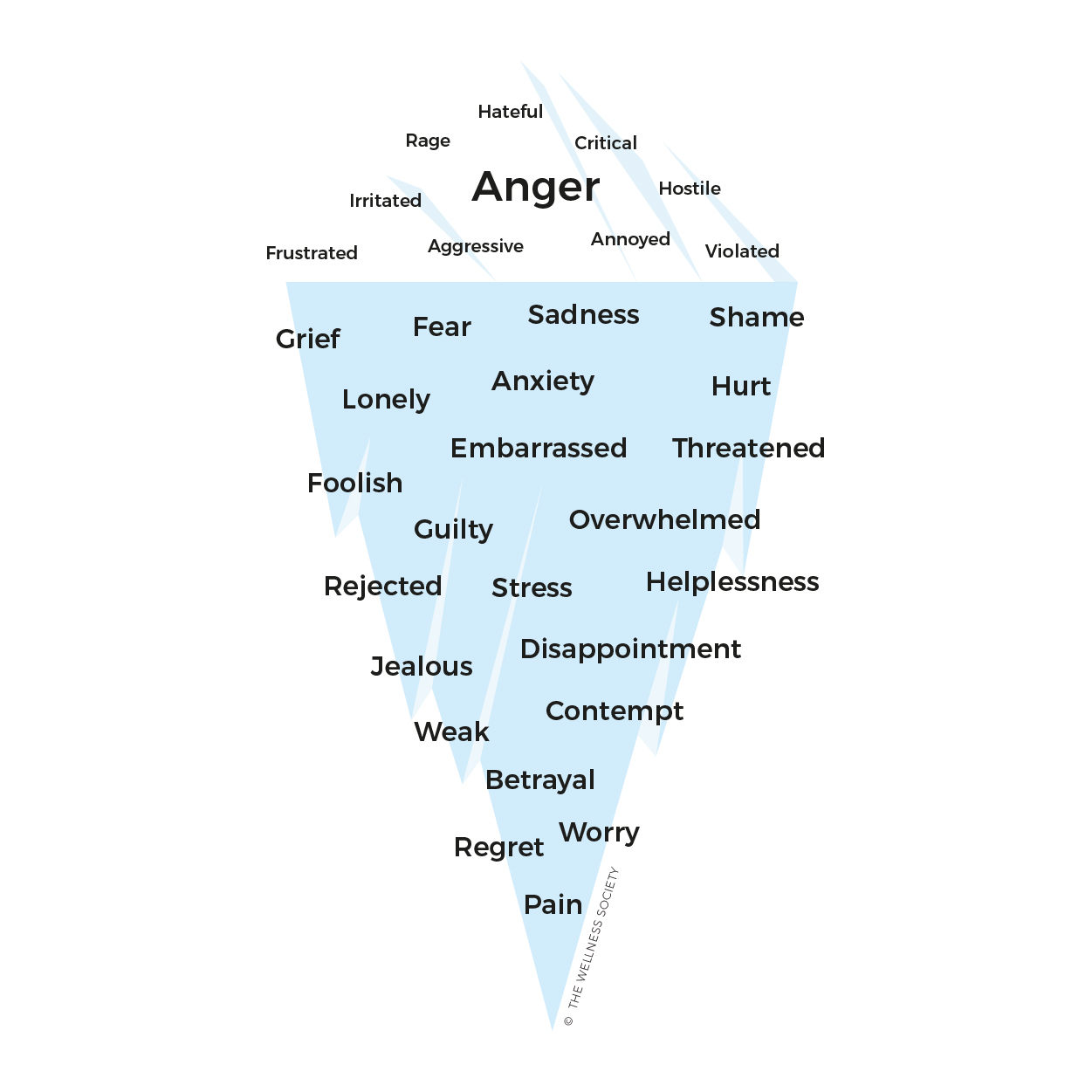“Anger is the go-to feeling for most people because it’s outward-directed - angrily blaming others can feel deliciously sanctimonious. But often it’s only the tip of the iceberg, and if you look beneath the surface, you’ll glimpse submerged feelings you either weren’t aware of or didn’t want to show: fear, helplessness, envy, loneliness, insecurity. And if you can tolerate these deeper feelings long enough to understand them and listen to what they’re telling you, you’ll not only manage your anger in more productive ways, you also won’t be so angry all the time.” - Lori Gottlieb
Anger is often referred to as a secondary emotion. It’s thought that we subconsciously shift into anger to protect ourselves from more vulnerable, uncomfortable emotions such as fear and sadness.
Whereas anger provides us with a surge of energy and can help us feel powerful, fear and sadness are more difficult for us to sit with and express.
The Anger Iceberg represents this psychological phenomenon. Although anger is what we see on the surface, there’s often a range of emotions hidden underneath.

Anger Coping Skills
Track Your Triggers
If you use an Anger Log regularly, your anger triggers will eventually become clearer.
Over time, you can note the emotions, people, places and situations that predispose you to losing your cool.
Once you become more familiar with your triggers, you’ll be better prepared to deal with them.
Notice Your Anger Warning Signs
People often say that their anger “just seems to come out of nowhere”, when in fact there are several physical warning signs that anger is rising.
Recognizing and understanding these signs helps with successful anger management.
Common anger signs include:
- Feeling hot
- Sweating
- Clenching your fists
- An increased heart rate
- Tensing your muscles
- Shaking
Next time you feel your anger levels rising, practice tuning into your body and seeing what you notice.
Identify Unhelpful Thoughts
Studies suggest that the feeling of anger is often influenced by the thinking pattern a person has about a situation.
Examples of thinking patterns that feed anger include catastrophizing, blaming and overgeneralizing.
- Catastrophizing: Making a mountain out of a molehill and assuming the worst-case scenario, e.g., “The train is running late – the whole day is probably ruined now!”
- Blaming: Blaming other people rather than acknowledging your own role in the situation, e.g., “What happened was all her fault!”
- Overgeneralizing: Seeing the world and other people in all-or-nothing terms, e.g., “You always do that and it’s so annoying!”
Noticing these thinking patterns without getting carried away by them can help you manage your anger.
Process Primary Emotions
Primary emotions are already present at birth and are experienced first in any given situation. Secondary emotions occur as the result of the reaction to the primary emotion.
Secondary emotions can be seen as learned behaviours, usually from family and society. An example is the statement, “boys don’t cry”. A man who has internalised this belief may respond to the primary emotion of sadness with anger.
To effectively deal with anger, it’s useful to process the primary emotions which drive it.
You can do this by reviewing the anger iceberg in your Anger Log, and writing down your feelings.
Develop Healthy Communication Skills
Healthy communication involves expressing your feelings, thoughts, and beliefs in an open, yet honest manner without violating the rights of others. It requires that the person state what occurred as a set of factual claims, instead of judging, shaming, blaming or negatively labelling.
Practice this using the Non-Violent Communication (NVC) framework (review the Assertiveness Worksheets in The Thinking Slow Method).
Don’t Vent Your Anger
The act of venting by using a physical outlet, such as screaming into a pillow or hitting a punching bag, does not actually reduce our levels of anger. In fact, venting may actually increase anger levels.
Responding to Anger Effectively
- Take a time out. Walking away from a triggering situation can be the quickest way to defuse anger.
- Practice a breathing exercise. Slow down your heart rate by slowing down your breathing. Review The Lasting Habits System for a range of exercises.
- Burn off the excess energy from anger with a brisk walk or run.
- Use a distraction technique. Review The Mental Wellbeing Toolkit and discover which distraction techniques work best for you when you’re dealing with challenging emotions.
Anger Log Contents
Here are the sections of our Anger Log, included in our free Anger Worksheets which you can download using the form below:
- Describe the situation. What triggered your anger?
- Try to think about the thoughts you were experiencing while feeling angry. Do you notice any catastrophizing, blaming or overgeneralizing?
- What were the warning signs that you were feeling angry?
- Review the anger iceberg image. Which emotions were you feeling?
- Try connecting your feelings to your needs. Which needs did your response relate to?
- How did you respond in the moment?
- Is there any way you might prevent this trigger from happening again? If not, how would you like to respond in future? Which coping skills could you have used in the moment?



